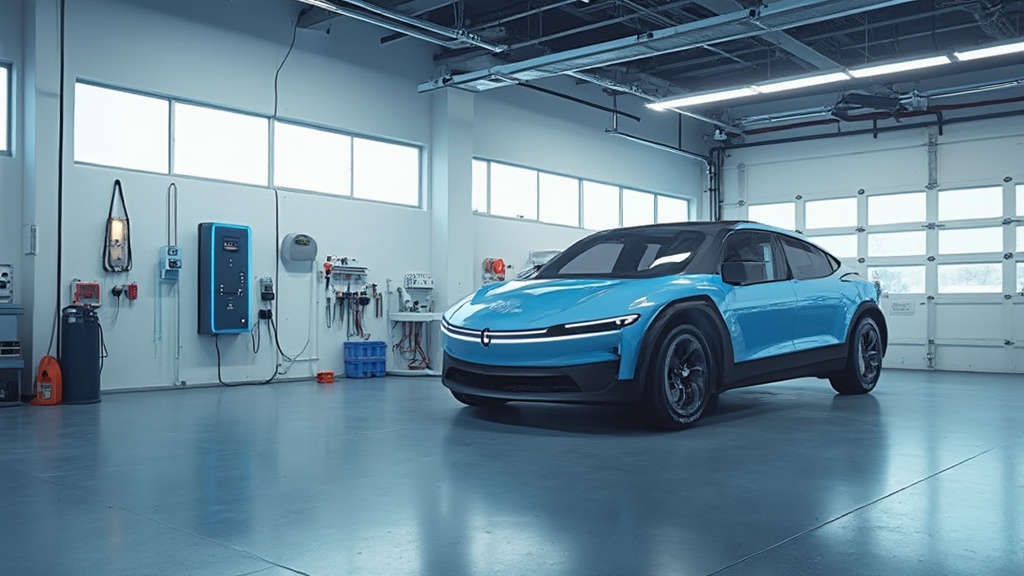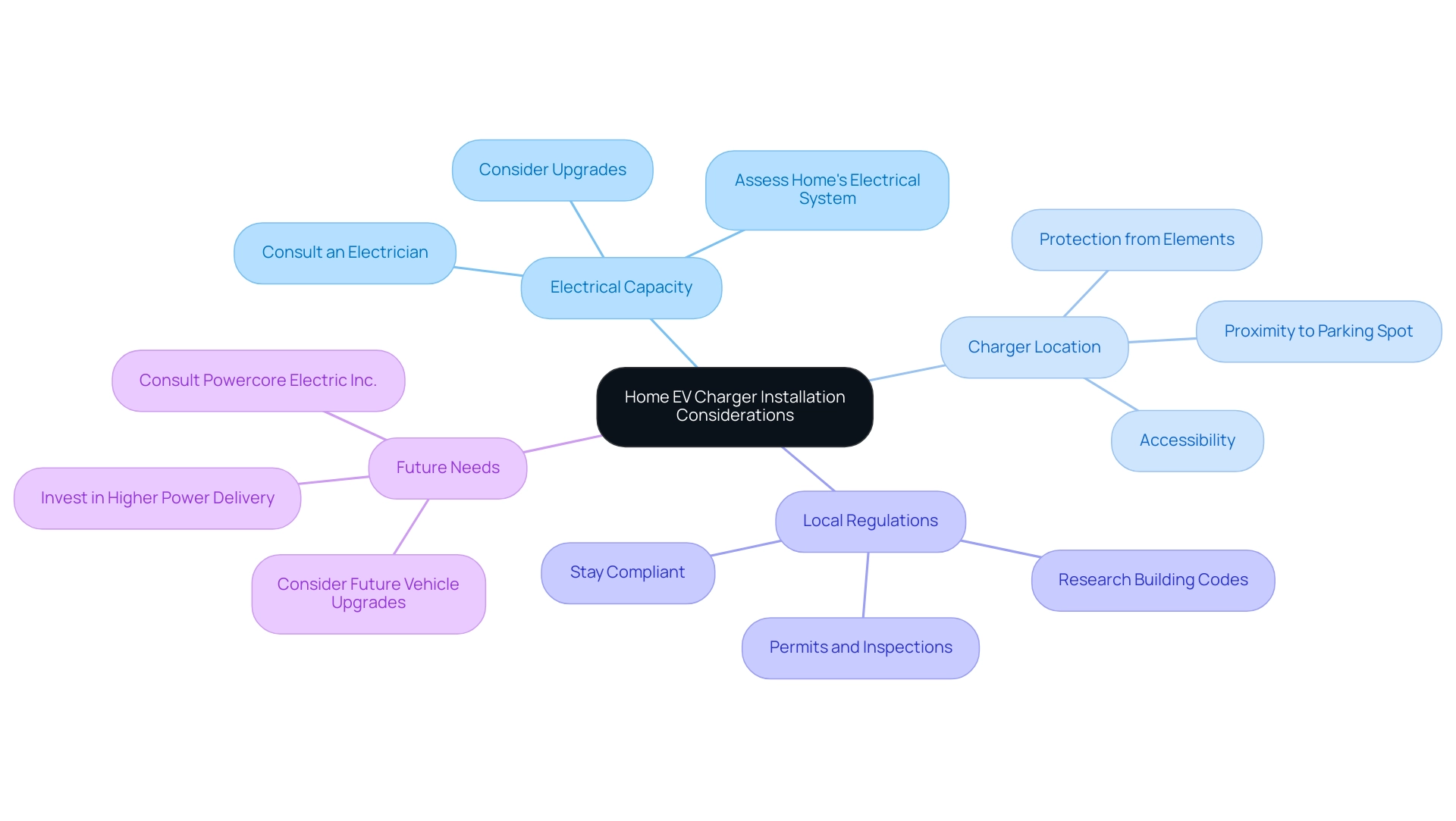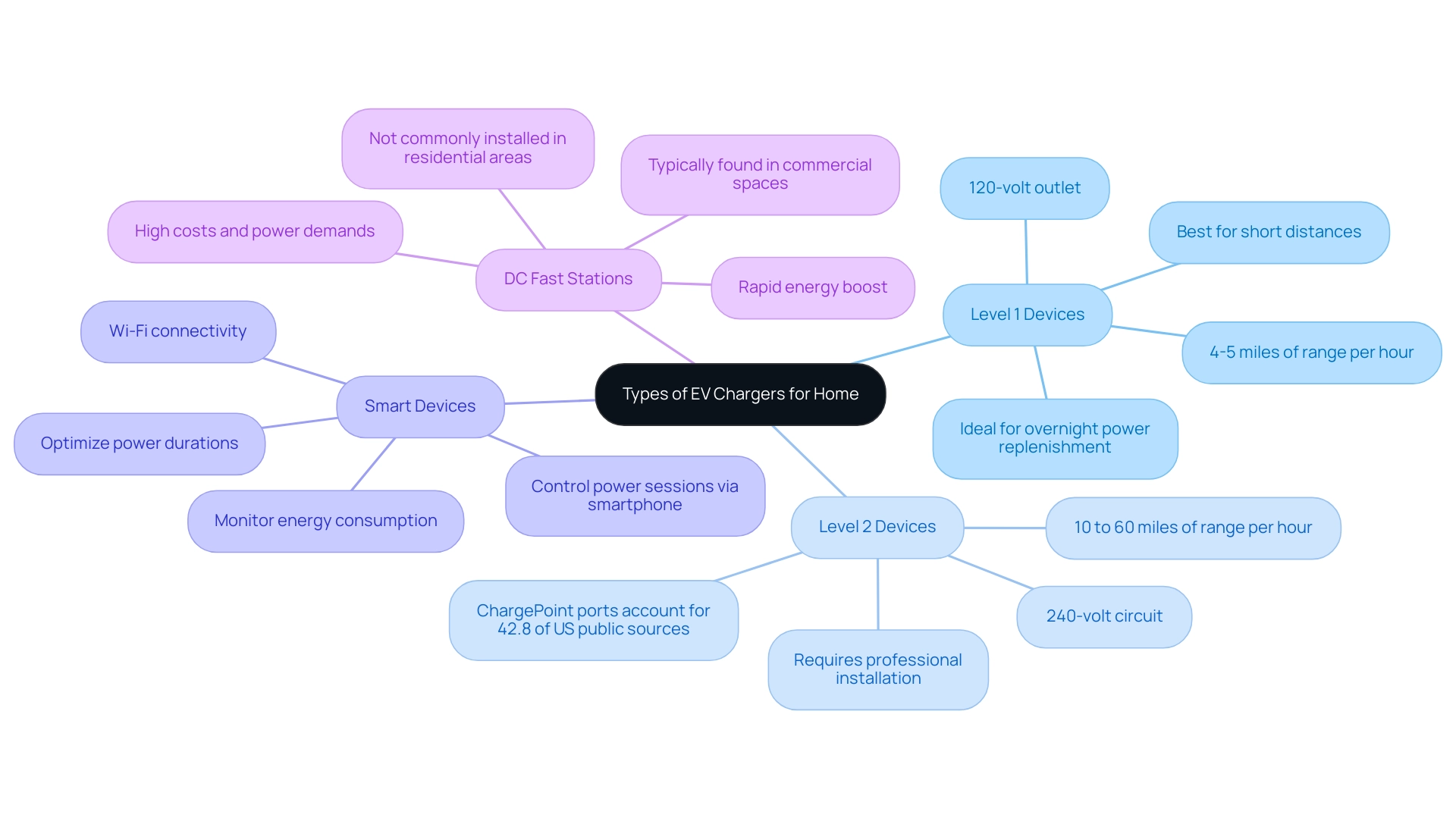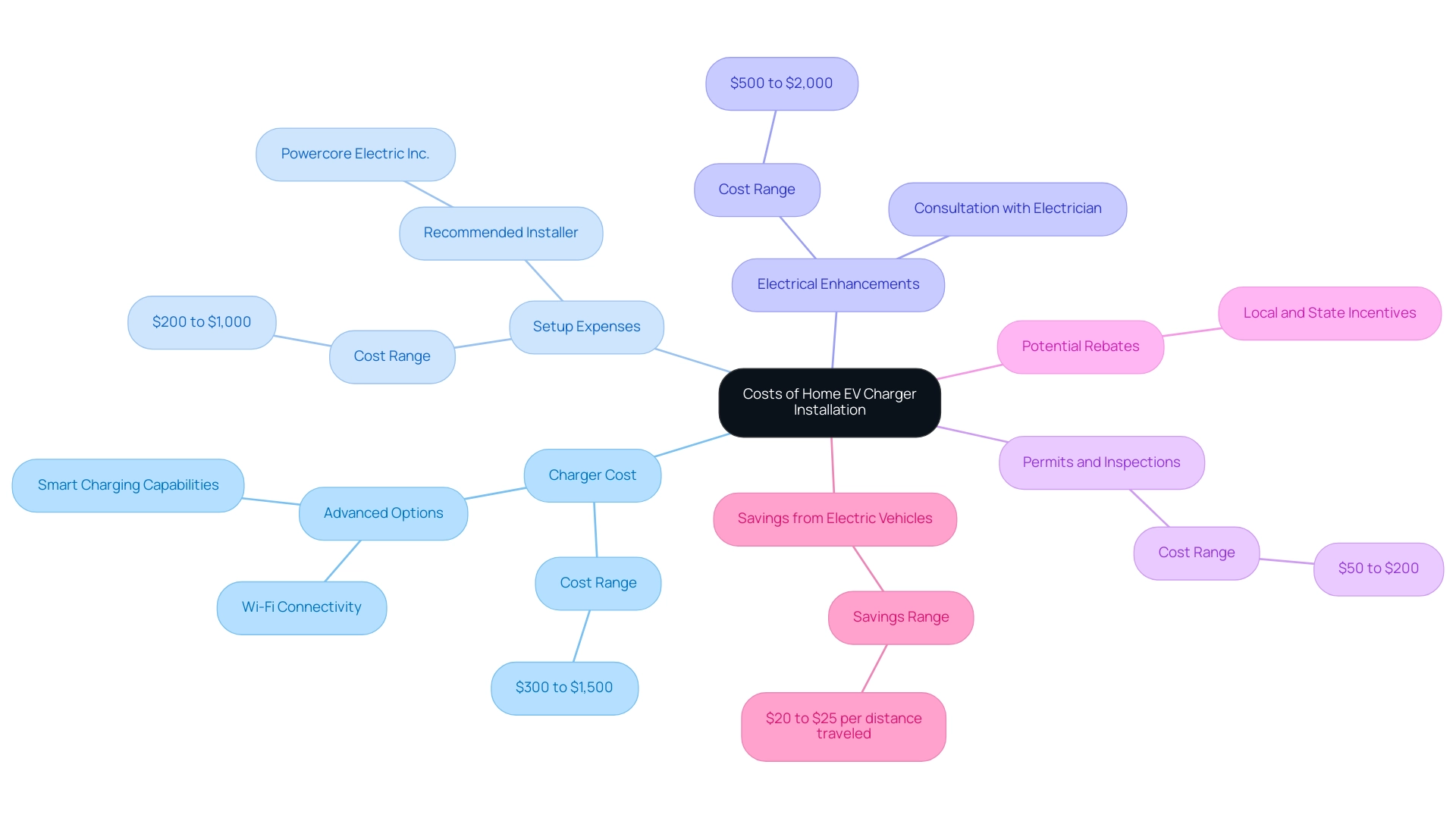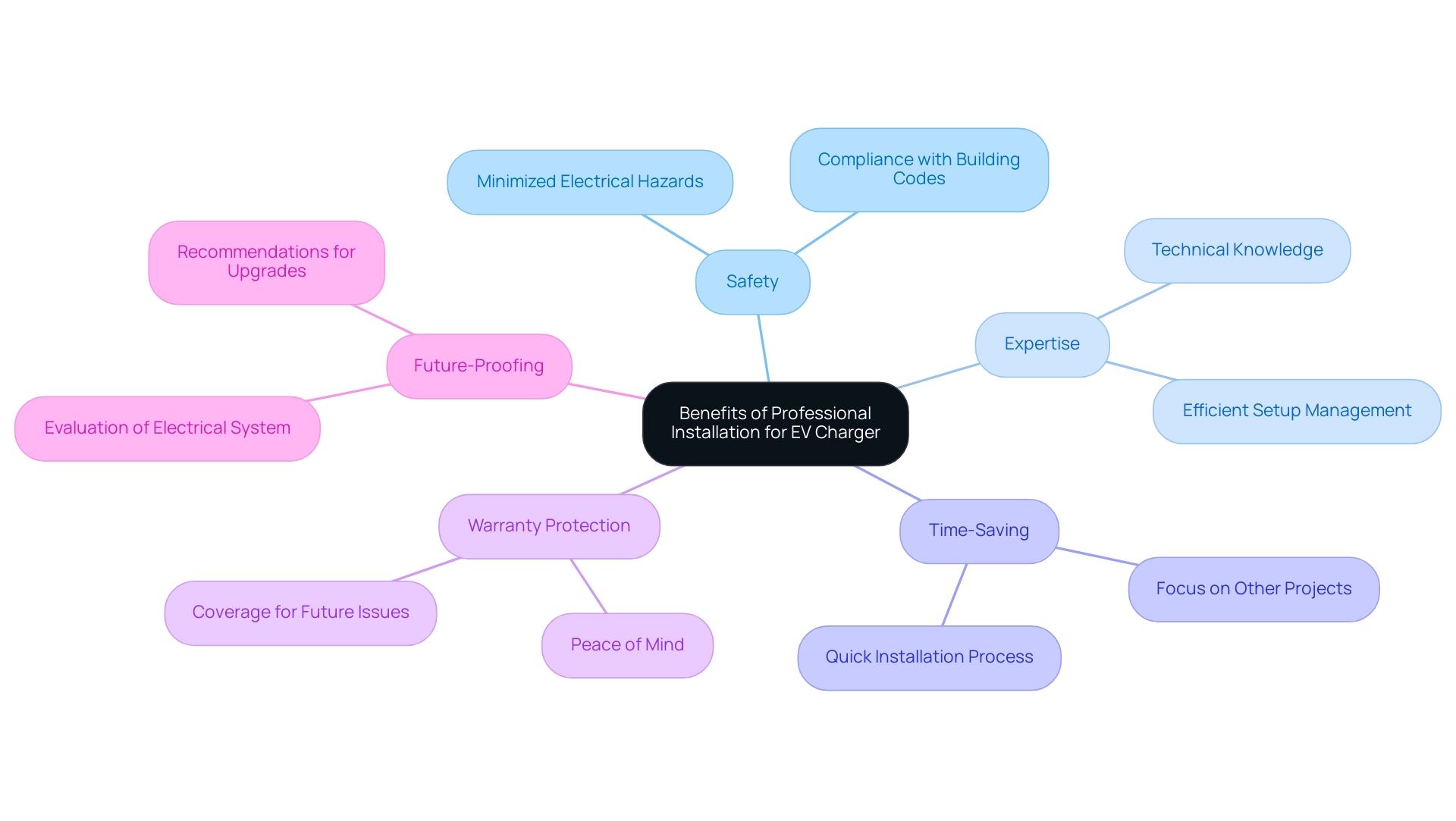Overview
Installing a home EV charger requires careful consideration of factors such as electrical capacity, charger location, local regulations, and future needs to ensure a successful setup. The article outlines a comprehensive step-by-step guide for installation, emphasizing the importance of consulting professionals like Powercore Electric to handle electrical upgrades and safety compliance, ultimately enhancing the convenience and efficiency of electric vehicle ownership.
Introduction
As electric vehicles (EVs) continue to revolutionize the way people think about transportation, the need for home charging solutions becomes increasingly important. Installing an EV charger at home not only enhances convenience but also paves the way for a sustainable future.
However, before diving into this project, homeowners must consider several essential factors to ensure a smooth and successful installation:
- Assessing electrical capacity
- Understanding local regulations
- Choosing the right charger type
Each step plays a critical role in the installation process. This guide will walk through the key considerations and steps involved, empowering homeowners to make informed decisions and embrace the electric vehicle movement with confidence.
Essential Considerations for Home EV Charger Installation
Before you embark on your EV installation journey, it’s essential to take a moment and consider these key factors to ensure a successful setup:
- Electrical Capacity: Start by assessing your home’s electrical system to confirm it can handle the extra load from an EV charger. It’s a smart move to consult with a qualified electrician from Powercore Electric Inc., who can help you evaluate whether any upgrades are necessary to accommodate your charging needs. Remember, proper installation is crucial, especially as the demand for EV infrastructure grows nationwide.
- Charger Location: Think about where you park your vehicle. Choosing a convenient location for the device is crucial—ideally, it should be close to your parking spot. Keep accessibility in mind, as well as protection from the elements, to make your power experience as seamless as possible. With the rise of charging hubs across the country, having a home station can complement these centralized locations equipped with multiple charging points for EVs.
- Local Regulations: Don’t overlook the importance of local building codes and regulations concerning EV charger setups. It’s a good idea to research these requirements early on, as some areas may require permits or inspections before you can move forward with setup. Understanding the evolving regulations can help you stay compliant and ensure a smooth installation process.
- Future Needs: As you reflect on your current power situation, don’t forget to think about your future EV aspirations. If you expect to upgrade to a more powerful vehicle in the future, it might be wise to invest in a charger that can support higher power delivery right from the start. Staying ahead of the curve is essential as the market grows, and Powercore Electric Inc. can assist you in choosing the right equipment for your requirements.
By keeping these factors in mind and contacting Powercore Electric Inc. for installing a home EV charger, you’ll be preparing for a smoother installation process and ensuring your space is well-equipped for all your electric vehicle needs. Additionally, by recharging at residence, you can experience substantial financial benefits over time, rendering it a wise option for environmentally aware property owners. Contact Powercore Electric Inc. today to learn more about how we can assist you with your EV charging needs!
Step-by-Step Guide to Installing Your Home EV Charger
Installing a home EV charger can be a rewarding project that makes electric vehicle ownership even more convenient. Here’s a friendly step-by-step guide to help you through the process:
-
Gather Your Tools and Materials: Before you dive in, make sure you have all the essential tools: a drill, screwdriver, and level will get you started.
Additionally, you’ll need the EV power source itself, along with mounting hardware and electrical wiring.
-
Turn Off Power: Safety first! Make sure to turn off the power to the area where you’ll be working.
This simple step can help prevent any electrical mishaps as you are installing a home EV charger.
-
Site Assessment: Consider having a professional like Powercore Electric conduct a thorough evaluation of your property to determine the best location for the charging station and assess any electrical requirements.
-
Electrical Upgrades: If your existing electrical infrastructure isn’t up to par, you may need to upgrade or modify it.
This step ensures your home can accommodate the charging station safely.
-
Mount the Device: Use a level to find the perfect spot for your device.
Securely mount it to the wall, keeping in mind a comfortable height for plugging in your vehicle.
-
Run Electrical Wiring: If you’re skilled with electrical tasks, you can run the wiring from your electrical panel to the charging point.
If this seems daunting, don’t hesitate to hire a licensed electrician to ensure everything is done safely.
-
Connect the Power Supply: Next, follow the manufacturer’s instructions to link your device to the electrical supply.
Ensure that all connections are snug and secure to avoid any issues down the road.
-
Turn On Power and Test: With everything in place, turn the power back on and test the device.
Look for any error messages and ensure it’s functioning correctly—this is the moment to see your hard work pay off!
-
Testing and Commissioning: After setup, it’s crucial to conduct rigorous testing to ensure that the device operates optimally.
This step confirms that everything has been installed correctly and is functioning as intended.
-
Clean Up: Finally, don’t forget to tidy up your workspace.
Put away all tools and clear any debris to leave your area neat and safe.
As a bonus, it’s interesting to note that the average time for installing a home EV charger is generally around 4 to 8 hours, depending on your prior experience and the complexity involved in installing a home EV charger.
With the increasing number of fueling stations projected to reach 8.2 million in the U.S. by 2035, you’re certainly making a wise investment in sustainable living.
This growth in infrastructure is backed by a cumulative private investment in medium- and heavy-duty vehicle refueling infrastructure in the United States, which totaled USD 4.2 billion by the end of 2023.
Additionally, examining global initiatives, India’s FAME II program emphasizes the significance of power supply infrastructure development, as it requires chargers to be installed every 25 km along major highways.
Remember, if you have any doubts during the process, seeking advice from experts can provide peace of mind and ensure a safe installation.
Ready to make the switch to electric vehicles?
Contact Powercore Electric today to learn more about our EV charging solutions and how we can help you embrace a cleaner, more sustainable future.
Choosing the Right Type of EV Charger for Your Home
When it comes to choosing the right EV charger for your home, it’s essential to understand the different types available and how they align with your lifestyle. Here’s a friendly breakdown:
-
Level 1 Devices: Utilizing a standard 120-volt outlet, Level 1 devices are the slow and steady option, providing around 4-5 miles of range per hour.
They’re ideal for overnight power replenishment, especially in residences with minimal energy requirements. If you primarily drive short distances, this could be a great fit.
-
Level 2 Devices: Functioning on a 240-volt circuit, Level 2 devices are the workhorses of home power supply, providing between 10 to 60 miles of range per hour.
They’re ideal for most households, but installing a home EV charger does require professional installation to ensure safety and efficiency. Significantly, ChargePoint ports represent 42.8% of all US public power sources, emphasizing the dominance of this kind of device in the power infrastructure landscape.
-
Smart Devices: These are a modern twist on Level 2 units, equipped with Wi-Fi connectivity.
With intelligent devices, you can oversee and control your power sessions directly from your smartphone, assisting you in optimizing power durations and monitoring energy consumption, which can harmonize wonderfully with your environmentally friendly objectives.
-
DC Fast Stations: While these devices can deliver a rapid boost of energy, they are typically found in commercial spaces and are not commonly installed in residential areas due to their high costs and power demands.
As you evaluate your driving habits, the electrical capacity of your home, and your budget, consider that installing a home EV charger could be beneficial, especially since the number of publicly accessible stations in Europe increased by 30% in 2021, reflecting growing trends in availability. Additionally, according to the Pew Research Center, California has the most EV charging infrastructure of any state, which may influence your decision based on local options available.
For more information on our services, including solar panels and battery backups, feel free to contact us at Powercore Electric Inc. at (916) 699-8778 or email ryan.serrano@powercoreinc.net.
We’re here to assist you in choosing the power adapter that best fits your requirements while supporting your journey into a more sustainable lifestyle!
Understanding the Costs of Home EV Charger Installation
When planning your budget for a home EV charger installation, it’s essential to take several key costs into account:
- Charger Cost: The price of EV chargers typically falls between $300 and $1,500, depending on the type and features you choose. Chargers with advanced options like Wi-Fi connectivity or smart charging capabilities might come at a premium, as noted by industry experts, but they can offer added convenience.
- Setup Expenses: Employing an expert for the setup can vary from $200 to $1,000. This variance largely depends on the complexity of the setup and the going rates for labor in your area. For a dependable setup experience, consider Powercore Electric Inc., which specializes in EV charging stations and has a strong reputation for quality service.
- Electrical Enhancements: If your existing residence configuration requires an electrical upgrade to support the device, you might discover yourself adding anywhere from $500 to $2,000 to your overall expense. It’s a good idea to consult with an electrician to understand what upgrades might be necessary.
- Permits and Inspections: Depending on your locality, you may need permits or inspections to proceed, which could add another $50 to $200 to your costs.
- Potential Rebates: Don’t forget to check for local or state incentives! Numerous areas provide incentives for EV equipment setups, which can greatly assist in reducing these costs and making the transition to electric even more economical.
Moreover, it’s essential to take into account the savings associated with operating an electric vehicle. Research indicates that electric SUVs and compact sedans save $20 to $25 relative to gasoline-powered vehicles for the same distance traveled, rendering the investment in an EV power source even more beneficial.
By being aware of these expenses beforehand, you can efficiently plan and allocate funds for installing a home EV charger, which will facilitate a smoother and more manageable transition to electric driving. Powercore Electric Inc. provides a variety of services, including solar panel setups and battery backups, along with their expertise in EV charging station configurations. For more information on services offered, feel free to reach out to Powercore Electric Inc. at ryan.serrano@powercoreinc.net or call (916) 699-8778.
The Benefits of Professional Installation for Your EV Charger
When it comes to installing your home EV charger, opting for professional installation with Powercore Electric offers a range of significant benefits:
- Safety: Our licensed electricians ensure that the setup is not only safe but also complies with local building codes, minimizing the risk of electrical hazards that can arise from DIY projects.
- Expertise: At Powercore Electric, our skilled team offers valuable technical knowledge, effectively managing the complexities that may occur during setup. This guarantees that everything is set up correctly and efficiently.
- Time-Saving: By hiring our experts, you can save precious time and effort, allowing you to focus on what truly matters, whether that’s enjoying your new EV or tending to other home projects.
- Warranty Protection: Many manufacturers provide warranties contingent upon professional installation. Knowing that your charger is installed by a qualified electrician gives you peace of mind, ensuring you’re covered in case of future issues.
- Future-Proofing: Our professionals can evaluate your home’s electrical system, recommending necessary upgrades to support your EV charging needs well into the future.
As one satisfied customer noted, “Ryan and his team were great. They were fast, efficient, and stayed on schedule for our solar setup.” This sentiment reflects the commitment of Powercore Electric to exceptional service, as we have proudly served California for over 30 years. While it might be tempting to consider DIY installation, the advantages of professional installation—particularly in terms of safety, efficiency, and long-term peace of mind—far outweigh the initial cost savings when it comes to installing a home EV charger.
As we observe expansion in the EV market, particularly in multi-unit residential environments expected to comprise around 15% of the market by 2025, ensuring a safe and effective power supply arrangement becomes even more essential. In fact, the at-work and multi-unit residential segments are recognized as the fastest-growing areas for EV infrastructure, with projections indicating substantial increases in charge points by 2030. This highlights the importance of professional installation to meet evolving market demands and ensure a reliable charging infrastructure, all while remaining committed to serving our California communities with our full range of services, including solar panels and battery backups.
Conclusion
Embracing the electric vehicle revolution starts at home, and installing an EV charger is a vital step in that journey. By assessing your electrical capacity, selecting the right charger type, and understanding local regulations, homeowners can ensure a smooth installation process. Each of these considerations lays the groundwork for a successful setup, ultimately enhancing convenience and supporting sustainable living.
The installation itself can be a rewarding experience, especially when following a structured approach that includes:
- Gathering the right tools
- Ensuring safety through power shutdowns
- Possibly consulting professionals for a thorough assessment
Opting for professional installation offers additional benefits such as:
- Safety
- Expertise
- Warranty protection
This makes it a wise choice for those looking to future-proof their home.
Finally, understanding the costs associated with installation, from charger prices to potential rebates, empowers homeowners to budget effectively and reap long-term savings. As the infrastructure for electric vehicles continues to expand, investing in a home charger not only contributes to personal convenience but also aligns with a broader commitment to a cleaner, more sustainable future. By taking these steps, homeowners can confidently join the electric vehicle movement and enjoy the many benefits that come with it.


